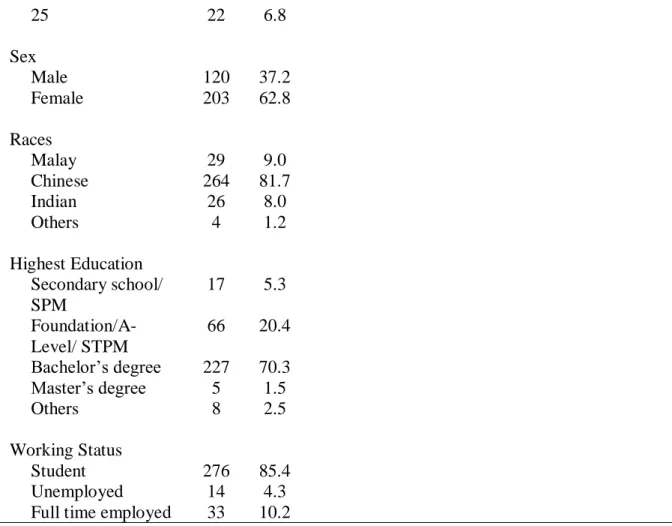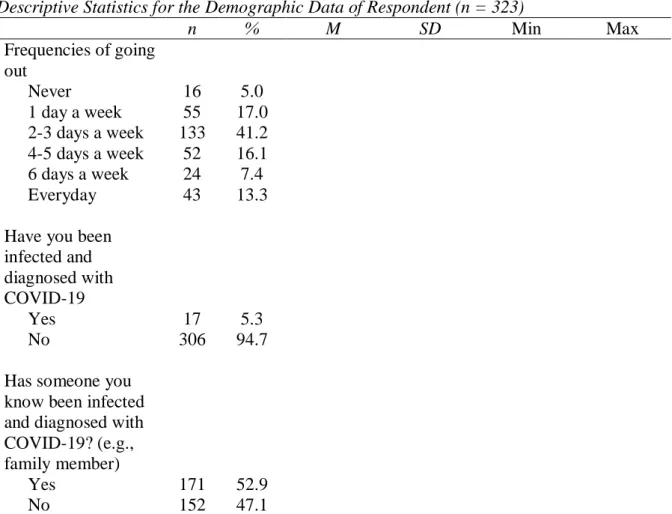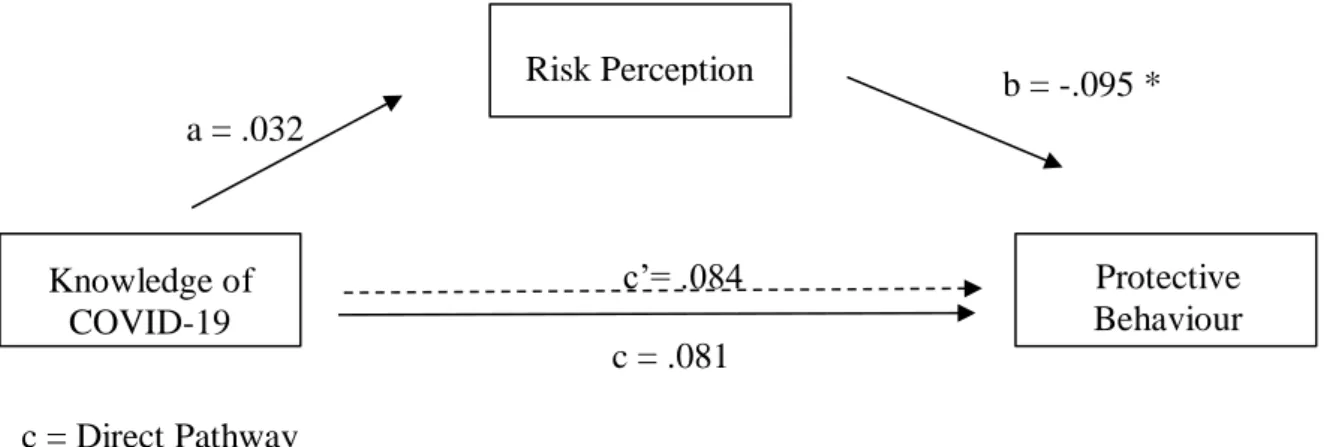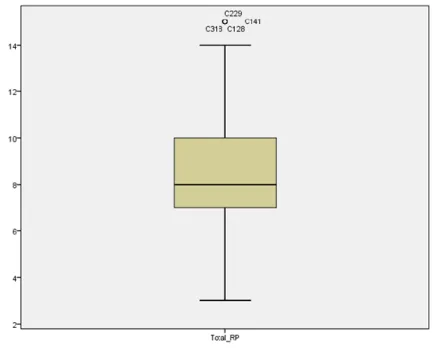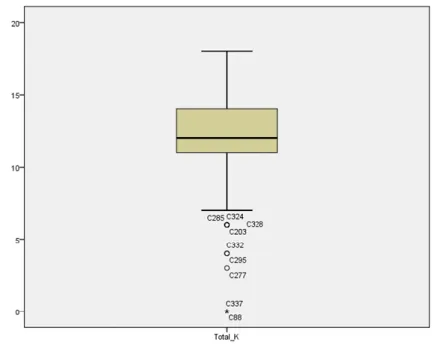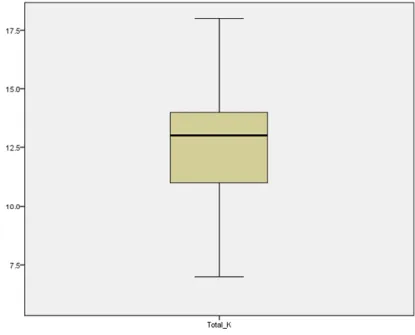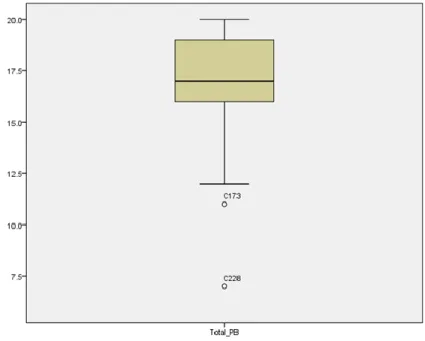This research project is submitted in partial fulfillment of the requirements for the Bachelor of Social Sciences (Hons) Psychology, Faculty of Arts and Social Sciences, Universiti Tunku. This research paper entitled “Knowledge, risk perception and protective behavior among Malaysian young adults during the COVID-19 pandemic” attached here was prepared and submitted by “Gan Hui Min, Jeanette Elena Tan and Swi Zi Qing” in partial fulfillment of the requirements for the Bachelor of Social Sciences (Hons) Psychology is hereby accepted. A previous study noted that an individual's knowledge and perception of the risk of COVID-19 may contribute to protective behavior.
Therefore, our study aimed to investigate the role of risk perception as a mediator between knowledge and protective behavior of COVID-19. Furthermore, our study also hypothesized that knowledge predicts an individual's protective behavior through risk perception as a mediator. The regression model result found that knowledge (β = .026, p = .640) does not significantly predict risk perception; knowledge (β . = .082, p = .140) does not significantly predict protective behavior; while only risk perception (β = -.112, p = .044) significantly predicted protective behavior among young adults in Malaysia.
Moreover, the findings of mediation analysis showed no significant mediating effect of risk perception on knowledge and protective behavior. Protective Behavior towards COVID-19 17 Knowledge and Risk Perception about COVID-19 18 Knowledge and Protective Behavior towards.
Introduction
One of the factors to predict the protective behavior of COVID-19 is the individual's knowledge of COVID-19. To identify the levels of knowledge, risk perception and protective behavior of COVID-19 among Malaysian young adults during COVID-19 pandemic. To investigate the predictive role of knowledge of COVID-19 on protective behavior among Malaysian young adults during COVID-19 pandemic.
To examine the predictive role of risk perception on protective behavior among young adults in Malaysia during the COVID-19 pandemic. To examine the mediating effect of risk perception on the relationship between knowledge about COVID-19 and protective behavior among young adults in Malaysia during the COVID-19 pandemic. What are the levels of knowledge, risk perception and protective behavior regarding COVID-19 among young adults in Malaysia during the COVID-19 pandemic.
Does risk perception have an indirect effect on the relationship between knowledge about COVID-19 and protective behavior among young adults in Malaysia during the COVID-19 pandemic. H4: Risk perception has a mediating effect on the relationship between knowledge about COVID-19 and protective behavior among young adults in Malaysia during the COVID-19 pandemic.
Literature Review
The transmission of COVID-19 is faster than both previous epidemics, which are SARS and MERS (Middle East Respiratory Syndrome) (Cori et al., 2020). Protective behavior from COVID-19 is how people engage in a behavior that avoids or reduces the risk of COVID-19 infection (Zickfeld et al., 2020). Another study by Moussaoui et al. 2020) mentioned that one of the ways to cope with COVID-19 and reduce the risk of infection is to adopt protective behaviors.
Cori et al., (2020) also mentioned that before people take protective actions, the risk of COVID-19 is assessed by several factors, such as knowledge. Therefore, it is important to consider knowledge about COVID-19 in the study of the predictive effect on risk perception. The protective behavior during the COVID-19 pandemic is largely associated with knowledge about COVID-19.
According to Alegria et al. 2021), the study reported that risk perception is one of the factors underlying the behavioral response related to COVID-19. It is important to test the relationship between risk perception and protective behavior for the COVID-19 pandemic in Malaysia.
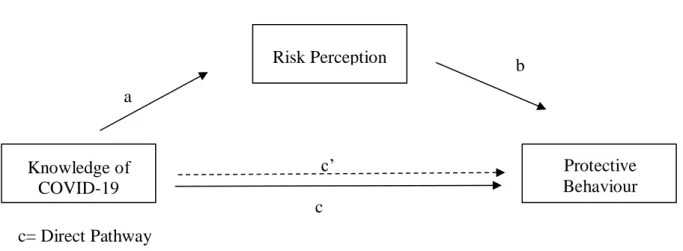
Methodology
This study recruited Malaysian young adults aged 18 to 25 years as the previous study found that those aged 20 to 24 years are reported to have a higher infection rate for COVID-19 (Povera, 2020). As the risk perception of Malaysian young adults is considerably low and they have reported to have high mortality and infection rate of COVID-19 in Malaysia, the selection criteria for this study are Malaysian young adults aged from 18 to 25 years. The SKAPCOV-19 questionnaire will measure respondents' basic knowledge about the etiology, risk groups, transmission and prevention of COVID-19.
The questionnaire includes an item such as "I think I am likely to get infected with COVID-19". Protective behavior is measured using four self-report scale items from the COVID-19 Protective Behavior Questionnaire (Shi et al., 2021). Items include “I regularly wash my hands and maintain hand hygiene” to check whether participants are behaving protectively during the COVID-19 pandemic.
H2: Knowledge of COVID-19 significantly predicts protective behavior among Malaysian young adults during the COVID-19 pandemic. ; H3: Risk perception significantly predicts protective behavior among Malaysian young adults during the COVID-19 pandemic). In addition, the mediation process (H4: Risk perception mediates the relationship between knowledge of COVID-19 and protective behavior among Malaysian young adults during the COVID-19 pandemic.) was tested using the PROCESS macro.
Results
Risk perception has no indirect effect on the relationship between knowledge about COVID-19 and protective behavior among young adults in Malaysia during the COVID-19 pandemic. The first objective of this study was to examine the level of knowledge, risk perception and protective behavior regarding COVID-19 among young adults in Malaysia during the COVID-19 pandemic. Therefore, the results can explain that there is no significant relationship between knowledge about COVID-19 and risk perception.
The result revealed that Malaysian young adults' knowledge about COVID-19 will not contribute to protective behavior via risk perception. Furthermore, this study can report Malaysian young adults' perceptions of the risk of COVID-19 and protective behaviors. In a nutshell, these findings suggested that most Malaysian young adults' COVID-19-related knowledge and risk perception are average, and protective behaviors are beyond.
The current study shows no significant predictive effect of knowledge of COVID-19 on risk perception and protective behavior. This study also shows that there is no mediating effect of risk perception on the relationship of knowledge of COVID-19 and protective behavior among Malaysian young adults during COVID-19. Knowledge, preventive behavior and risk perception of the COVID-19 pandemic: A cross-sectional study in Turkish healthcare workers.
Knowledge, protective behavior and risk perception of COVID-19 among dental students in India: a cross-sectional analysis (Batra et al., 2021).

Questionnaire
ABSTRACT (5%) Max Score
Mark the results of the research. manipulation, participant flow, adherence to treatment, baseline data, side effects and side effects, allocation method and implementation, masking. if applicable to the research design).
DISCUSSION AND CONCLUSION (20%) Max Score
Required originality parameters and limits approved by UTAR are as follows:. i) Overall similarity index is 20% or less, and. ii) Matching of individual listed sources must be less than 3% each, and (iii) Matching texts in consecutive block must not exceed 8 words. Note: Parameters (i) – (ii) must exclude citations, references and text matches that are less than 8 words. It is mandatory for the supervisor/examiner to provide the overall comments for research projects with grades A- and above or F.
Oral Presentation The schedule of the oral presentation will be published and your supervisor will inform you Gan Hui Min, Jeanette Elena Tan, Swi Zi Qing. The duration listed is for reference only, supervisors can adjust the period according to the topics and content of the projects. The deadline cannot be changed, one mark will be deducted per day for late submission.
